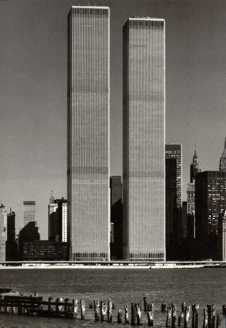 |
 |
 |
 |
 |
 |
 |
 |
 |
 |
 |
 |
 |
 |
 |
 |
 |
 |
 |
 |
 |
 |
 |
 |
 |
 |
 |
 |
 |
 |
 |
 |
 |
 |
 |
 |
 |
 |
 |
 |
 |
 |
 |
 |
 |
 |
 |
 |
 |
 |
 |
 |
 |
 |
 |
 |
 |
 |
 |
 |
 |
 |
 |
 |
 |
 |
 |
 |
 |
 |
 |
 |
 |
 |
 |
 |
 |
 |
 |
 |
 |
 |
 |
|
|
 |
|
|
|
 |
|
|
|
(1993)
the first attack |
|
|
|
[TERRORISM] |
|
|
|
 |
|
|
|
 |
|
|
|
On February 26th, 1993, at 12:18 P.M., the heart of New York City's financial district shook with blows of terrorism felt throughout the world. The World Trade Center, considered one of the premiere office locations in the city, experienced an explosion which ripped through the subgrade levels of its parking facility beneath the New York Vista Hotel. The firey explosion took out several sections of the garage, and within short minutes smoke fumed throughout the structure, spreading soot completely through the 220 floor office facility, its lobbies and concourse areas. Total casualties claimed included six persons killed, more than 1000 persons injured, and 350 businesses were forced out of the center's twin towers (see endnote #1). [More than 90,000 persons worked or visited the complex daily.) It was found that the explosion blasted a hole 100 feet wide through the ground-level floor of a hotel, and knocked down part of a masonry wall which separated the garage from the adjacent subway station, also collapsing part of that station's ceiling. |
|
|
|
Immediately after the explosion, the Port Authority of New York and New Jersey's risk management department began to create a recovery action plan which required evacuating the complex, contacting the proper authorities and setting up an emergency operations center [EOC] where their tenant assistance program was implemented (see endnote #2). On the same evening as the explosion the Port Authority's risk department started the cleanup operation by bringing a representative of The Restoration Company [TRC] to the scene. TRC assessed the building's smoke and fire damage and identified several major issues that needed to be addressed before cleanup could begin. There needed to be coordination of the overall project; the re-establishment of security; the creation of communication lines between groups and subcontractors; supplies needed to be procured; health and safety standards needed to met and maintained; and a Critical Path Management Program needed to be established to complete the work in an efficient and timely manner. Because business interruption insurance losses and the loss of tenant's rents was calculated at over one million per diem, the TRC's additional goal was to have the 220 floors [8.8 million square feet] cleaned and ready in 21 days (see endnote #3). |
|
|
|
Prior to the terrorist incident, the need for virtually unbreakable backup systems and emergency procedures at the World Trade Center should have seemed obvious. The basic configuration of the building was so complex and so dependant on its electricity for lighting, ventilation and elevator service, that a major power outage had the potential to leave thousands of persons trapped in the upper floors for possibly hours. Yet, the lack of backup systems managed to escape the minds of the center's designers and management (see endnote #4). |
|
|
|
This was in spite of the fact that in 1985, the Port Authority of New Jersey and New York, which owns the World Trade Center Complex, had created an internal anti-terrorism task force for the purpose of evaluating the safety systems at the center. This task force had recommended more than 170 safety improvements, but at the time management chose to implement less than one-third, having chosen the least expensive and effective measures [ie: additional locks, more frequent security patrols.] In addition, the Port Authority also ignored proposals that if implemented would have minimized the amount of distruction of the 2/26/93 terrorist event. These recommendations had specifically identified problems regarding the vulnerability of the center's power supply [provided by its primary electric generators and located almost directly below the site of the 2/93 blast] and had strongly suggested moving those generators to alternate, less vulnerable areas. |
|
|
|
Unfortunately, the 2/93 explosion was in close proximity to the control systems and emergency command center, destroying primary as well as backup systems. Within minutes, after having been inundated by over 1.8 million gallons of water from broken plumbing lines, these generators failed. Immediately elevators stopped. Ventilating system's fans stopped and left occupants with no source of fresh air in all the smoke. Lighting shut off and without battery backup, the emergency lighting failed. Because the electrical and telephone service were concentrated together, when the electrical was affected, the explosion had severed five out of eight main power lines and enough of the telephone lines to disrupt all communication. Adding insult to injury, structural design deficiencies in the elevators shafts and fire stairs, allowed those areas to act as chimney like flues. This helped the dense smoke quickly move to penetrate the public concourse, subwaystations and all six buildings (see endnote #5). |
|
|
|
 |
|
|
|
The Insurance Industries breakdown for the bombing incident was as follows: (see endnote #6) |
|
|
|
WORLD TRADE CENTER BOMBING:
[Cost in millions] |
|
|
|
Total Gross Costs = $541 -> $592 est. |
|
|
|
Gross Costs to NY-NJ Port Authority = $376 -> $380 est. |
|
|
|
Net Financial Cost to NY-NJ Port Authority after insurance = $55 -> $94 |
|
|
|
Gross Costs to World Trade Center tenants = $132 -> $160 |
|
|
|
Net Financial Cost to World Trade Center tenants after insurance = $7 -> $25 |
|
|
|
Est. Gross Costs to NY City = $24 -> $41* |
|
|
|
NY City Business Disruption Costs = $ 8 |
|
|
|
NY City Emergency Response Costs = $14 -> $28 |
|
|
|
Emergency Health Care Costs = $2 -> $ 4 |
|
|
|
Est. Gross Costs to Manhattan businesses excluding the trade center = $8 -> $10 ** |
|
|
|
* These gross costs of between $ 24 million and $ 41 million will be offset by $ 3 million from insurance coverage and other sources. |
|
|
|
** offset by $ 1million in government assistance. |
|
|
|
 |
|
|
| The New York City Comptroller gave the following estimates (see endnote #7): |
|
|
| REPAIR OF BUILDING DAMAGE TOTAL= $60 million |
|
|
|
$5 million =>Cleanup, window repairs |
|
|
|
$5 million =>Phone line repair |
|
|
|
$15 million =>Structural repair/reinforcement |
|
|
|
$15 million =>Replacement of equipment |
|
|
|
$20 million =>New security systems |
|
|
| BUSINESS LOSSES TOTAL = $300 millions |
|
|
|
$30 million => Loss of work at WTC (1 day) |
|
|
|
$20 million => Inventory damage/loss |
|
|
|
$80 million => Loss of business |
|
|
|
$20 million => Records damage/loss |
|
|
|
$15 million => Health-related costs |
|
|
|
$30 million => Moving/temporary relocation |
|
|
|
$40 million => New security/redundancy |
|
|
|
$50 million => Traffic and transit disruption |
|
|
|
$15 million => Legal and accounting |
|
|
|
 |
|
|
|
During terrorist caused emergency situations, just as in natural disasters, there is no time to try to learn new procedures. It is utterly essential that emergency management activities be well practiced to the point of automatic deployment. In this case, there were no pre-established procedures, which led to time loss and confusion while the Port Authority scrambled to create its new plan of action. The National Institute for Urban Search and Rescue has established some guidelines for a national crisis information center architecture which should have been a "rule of thumb" for the Port Authority planners:"Deliver the Right information - To the Right People - Within the "action cycle" - To save the Greatest number of lives" (see endnote #8). These guidelines could provide a decent framework with which to identify what functionalities would be required of an emergency information network, at any or all three levels of local, state and national information infrastructures. When the World Trade Tower was bombed, it could be said that the current available solutions at the time were in the wrong place, unknown, or simply unavailable. |
|
|
|
 |
|
|
| ENDNOTES for Case #1: |
|
|
| 1. Thomas Lueck, "Back to Work Amide Soot and Stress" New York Times Section B col 4 p.4 3/9/93 |
|
|
| 2. Bill Boss, "A Case Study: Cleaning Up the World Trade Center" Risk Management (New York:Risk Mgmt Publishing Society Inc, Oct.93) p. 57 |
|
|
| 3. "A Case Study: Cleaning Up the World Trade Center" pp. 58-59 |
|
|
| 4. Joseph Mangan, "The Trade Center bombing: relearning old lessons; building safety design" Best's Review: Property-Casualty Insurance Edition vol 94; No.5; (A.M. Best Company Inc., 9/93) p.54 |
|
|
| 5. Joseph Mangan, "The Trade Center bombing: etc..." p.54 |
|
|
| 6. David Katz, "Insurance Covers Bulk of Loss to World Trade Ctr." Insurance Research Letter: National Underwriter Property & Casualty/Risk & Benefits Management Edition Section. Late Breaking News (TheNational Underwriter Co.,4/12/93) p.1 |
|
|
| 7. editor. "untitled' Business Insurance (Crain Communications, Inc., 3/8/93) p.69 |
|
|
| 8. John Grigsby, "Councils sound the alarm," The Daily Telegraph 11/11/93 p.20 |
|
|
|
 |
|
|
|
|
|
 |
|
|
|
|
|
|
 |
|
|
|
 |
|
|
|
|
(Updated 9/02/03 D.J. Russell) |
|
|
|
|
|
|
|
|
 |
|
|
|
|

|
|
|
|
|
|
|
|
 |
|
|
|
|
|
|
 |
|
|
|
|



